BIOMASS
Is an arts periodical that produces volumes on artistic praxis through featured exhibitions, recordings and artist interviews. Exploring artmaking through the interconnected life cycles of material, energy, and community, BIOMASS sheds light on the realities of creative labour for working artists. In depth conversations with featured artists share alternative pathways toward creative agency and art-making that take context into account.In light of mass environmental degradation, and the need for equitable social change across all fields and industries, artistic practices can offer a unique training ground for transformative and provocative invitations. BIOMASS emphasizes artistic practices as case studies for living and creating in more sustainable, holistic or realistic ways.
The term biomass has a multifold meaning. It refers to an accumulated mass of organisms in situ that supports biodiversity and traps carbon polution. However in the energy industry, the term has been co-opted to describe forms of “waste material” that is burned en masse to create electricity. The word’s etymology is more overt, bio meaning life and mass, volume. From these layered meanings we find an expandable terminology that may address issues of burnout, waste, reuse and regeneration in the field of creative labour.
By focusing on the realities of artmaking in daily life, BIOMASS shares work by artists whose approach to creative, monetary, personal and political constraints have developed creative agency to working within them.
BIOMASS is an independent project created by Liljana Mead Martin.

Image: Radial longitudinal section (RLS) of Viburnum wood showing inter-vessel pits and scalariform perforation plates.
Comparative wood anatomy of Viburnum L. (Adoxaceae) and its taxonomic implication. Study by: Balkrishna Ghimire, Dong Chan Son, Beom Kyun Park, Seung-Hwan Oh.
Comparative wood anatomy of Viburnum L. (Adoxaceae) and its taxonomic implication. Study by: Balkrishna Ghimire, Dong Chan Son, Beom Kyun Park, Seung-Hwan Oh.
